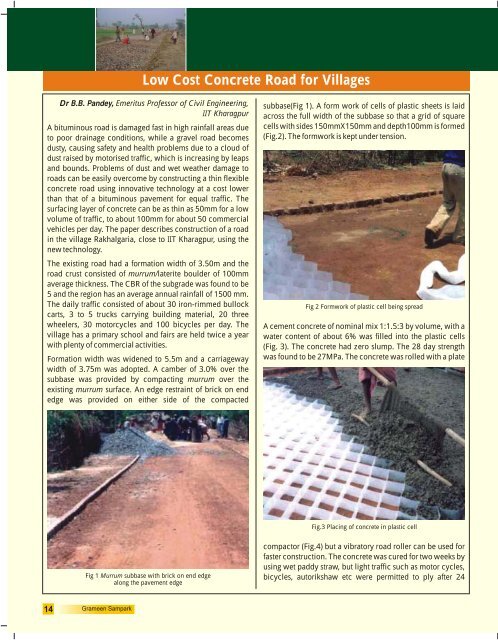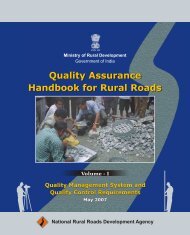Low Cost Concrete Road for Villages - pmgsy
Low Cost Concrete Road for Villages - pmgsy
Low Cost Concrete Road for Villages - pmgsy
Create successful ePaper yourself
Turn your PDF publications into a flip-book with our unique Google optimized e-Paper software.
Dr B.B. Pandey, Emeritus Professor of Civil Engineering,<br />
IIT Kharagpur<br />
A bituminous road is damaged fast in high rainfall areas due<br />
to poor drainage conditions, while a gravel road becomes<br />
dusty, causing safety and health problems due to a cloud of<br />
dust raised by motorised traffic, which is increasing by leaps<br />
and bounds. Problems of dust and wet weather damage to<br />
roads can be easily overcome by constructing a thin flexible<br />
concrete road using innovative technology at a cost lower<br />
than that of a bituminous pavement <strong>for</strong> equal traffic. The<br />
surfacing layer of concrete can be as thin as 50mm <strong>for</strong> a low<br />
volume of traffic, to about 100mm <strong>for</strong> about 50 commercial<br />
vehicles per day. The paper describes construction of a road<br />
in the village Rakhalgaria, close to IIT Kharagpur, using the<br />
new technology.<br />
The existing road had a <strong>for</strong>mation width of 3.50m and the<br />
road crust consisted of murrum/laterite boulder of 100mm<br />
average thickness. The CBR of the subgrade was found to be<br />
5 and the region has an average annual rainfall of 1500 mm.<br />
The daily traffic consisted of about 30 iron-rimmed bullock<br />
carts, 3 to 5 trucks carrying building material, 20 three<br />
wheelers, 30 motorcycles and 100 bicycles per day. The<br />
village has a primary school and fairs are held twice a year<br />
with plenty of commercial activities.<br />
Formation width was widened to 5.5m and a carriageway<br />
width of 3.75m was adopted. A camber of 3.0% over the<br />
subbase was provided by compacting murrum over the<br />
existing murrum surface. An edge restraint of brick on end<br />
edge was provided on either side of the compacted<br />
14<br />
Grameen Sampark<br />
<strong>Low</strong> <strong>Cost</strong> <strong>Concrete</strong> <strong>Road</strong> <strong>for</strong> <strong>Villages</strong><br />
Fig 1 Murrum subbase with brick on end edge<br />
along the pavement edge<br />
subbase(Fig 1). A <strong>for</strong>m work of cells of plastic sheets is laid<br />
across the full width of the subbase so that a grid of square<br />
cells with sides 150mmX150mm and depth100mm is <strong>for</strong>med<br />
(Fig.2). The <strong>for</strong>mwork is kept under tension.<br />
Fig 2 Formwork of plastic cell being spread<br />
A cement concrete of nominal mix 1:1.5:3 by volume, with a<br />
water content of about 6% was filled into the plastic cells<br />
(Fig. 3). The concrete had zero slump. The 28 day strength<br />
was found to be 27MPa. The concrete was rolled with a plate<br />
Fig.3 Placing of concrete in plastic cell<br />
compactor (Fig.4) but a vibratory road roller can be used <strong>for</strong><br />
faster construction. The concrete was cured <strong>for</strong> two weeks by<br />
using wet paddy straw, but light traffic such as motor cycles,<br />
bicycles, autorikshaw etc were permitted to ply after 24
Fig. 4 Compaction of zero slump concrete by a plate vibrator<br />
hours. Fig.5 shows the road surface after removal of paddy<br />
straw.<br />
Fig 5. A finished surface of the concrete road after removal of paddy<br />
straw used <strong>for</strong> wet curing<br />
The pavement was evaluated by Falling Weight<br />
Deflectometer (Fig. 6) using a dynamic load of 45kN on<br />
Documenting Impact of PMGSY<br />
Pradhan Mantri Gram Sadak Yojana<br />
300mm diameter plate. The equivalent elastic modulus of<br />
the 100mm compacted flexible concrete was about 4500<br />
MPa, three times the modulus of high strength bituminous<br />
concrete used in major highways. Its expected life is 15 to 20<br />
years. The cost of 250m long pavement with a hard shoulder<br />
of laterite boulder was found to be Rs.4.00 lakhs and the cost<br />
per kilometer is estimated as Rs16.00 lakhs .The entire cost<br />
was born by IIT Kharagpur. If CBR of the soil is 5 and above,<br />
no subbase is necessary. The students and scholars of Civil<br />
Engineering Department of the Institute were involved <strong>for</strong><br />
quality control. The construction is labour intensive and it is<br />
in consonance with the employment generation scheme of<br />
the Ministry of Rural Development.<br />
Rural <strong>Road</strong>s connectivity promotes access to economic and social services to the rural masses. Rural <strong>Road</strong>s provide the<br />
best means of reducing poverty through sustainable development and social economic trans<strong>for</strong>mation of Rural India. It<br />
is evidenced that rural accessibility has a marked impact on agriculture, employment generation, industry, health,<br />
education and other areas.<br />
NRRDA would like to systematically document the impact of connectivity being provided under PMGSY. Accordingly,<br />
we would welcome brief case-studies (preferably with digital photographs) depicting changes brought about by the<br />
programme in the socio-economic profile of the habitations benefitted. Articles, in MS Word (not exceeding 1200<br />
words), may kindly be sent to:<br />
Dr. B.P. Chandrasekhar, Director (Technical)<br />
National Rural <strong>Road</strong>s Development Agency<br />
5th Floor, NBCC Towers, Bhikaji Cama Place, New Delhi-110066<br />
Phone No: 011-41055550 (O), Fax No: 011- 41000475 (F),<br />
Email Id: bpc@nic.in<br />
Fig 6 Evaluation of pavement by FWD<br />
Grameen Sampark 15

















